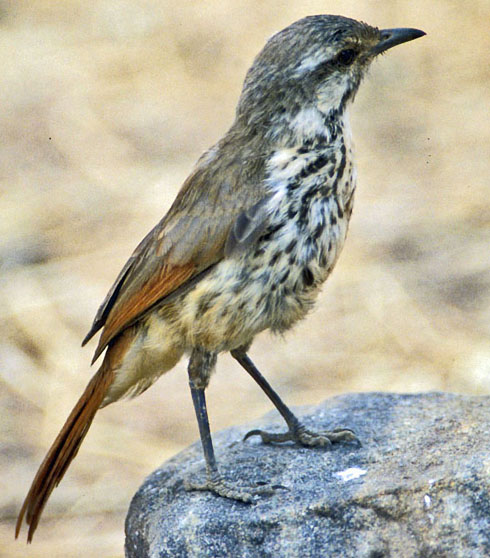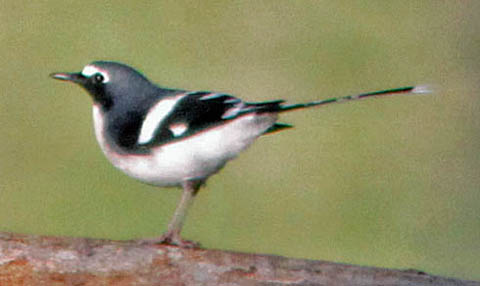| |
MUSCICAPIDS Muscicapidae
Old World flycatchers, Old World redstarts, robins & chats, forktails, wheatears, and allies |
- 322 species in the Old World (and Alaska)
- DR personal total: 194 species (60%), 92 photo'd
|
 The Muscicapidae is a huge family of smallish Old World passerines that includes not only many of the "flycatchers" of the Old World, but also a large number of "robins,""chats," and "bushchats," of which Gray Bushchat (left), a widespread roadside bird in the Himalayan foothills, is just one example. Other examples are the Old World redstarts, stonechats, shamas, forktails, wheatears, alethes, akalats, rock-thrushes, whistling-thrushes, shortwings, niltavas, and a large assortment of Old World flycatchers. Together, it might be best to think of them as "muscicapids," although, frankly, given the fact that American checklists and many handbooks (e.g., Taylor 2006) label them as "Old World flycatchers," that is what I tend to call them. The assortment of birds in this family is staggering. The forktails, residing along rushing streams in Eurasia, are gorgeous in black-and-white, as they bob in rhythm to raging water than surround them; an example is White-crowned Forktail (below). The Muscicapidae is a huge family of smallish Old World passerines that includes not only many of the "flycatchers" of the Old World, but also a large number of "robins,""chats," and "bushchats," of which Gray Bushchat (left), a widespread roadside bird in the Himalayan foothills, is just one example. Other examples are the Old World redstarts, stonechats, shamas, forktails, wheatears, alethes, akalats, rock-thrushes, whistling-thrushes, shortwings, niltavas, and a large assortment of Old World flycatchers. Together, it might be best to think of them as "muscicapids," although, frankly, given the fact that American checklists and many handbooks (e.g., Taylor 2006) label them as "Old World flycatchers," that is what I tend to call them. The assortment of birds in this family is staggering. The forktails, residing along rushing streams in Eurasia, are gorgeous in black-and-white, as they bob in rhythm to raging water than surround them; an example is White-crowned Forktail (below).
Except for small populations of Northern Wheatear and Bluethroat in Alaska and Canada, all muscicapids are Old World birds. Some undertake long migrations while others are entirely resident. The entire family is composed of insectivores, although the techniques to prey on insects and spiders ranges from 'perch-and-plunge,' to 'sally forth' fly-catching, or to scratching in the undergrowth. The diversity of form, colors, habitats, behaviors, vocalizations, and migrations is dazzling. |
 |
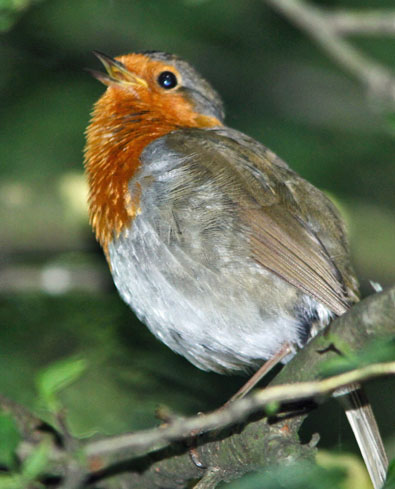 The taxonomic history of this group is checkered with uncertainties and contradictions. Well-known European species such as Common Nightingale Luscinia megarhynchos and European Robin (singing male, right) were within this group, but all were once considered a part of a huge group including thrushes, Old World warblers, babblers and allies (Mayr and Amadon 1951). Later the grouping was restricted but still included the batises, monarchs, and whistlers (Wetmore 1960) that are now known to be unrelated, separate families. Sibley & Ahlquist (1990) created a huge Muscicapidae with two subfamilies: the 'true thrushes" and than all the rest, which were divided into two tribes, the "chats" and the Old World flycatchers. Thereafter, for a time, the standard view evolved that there were basically two families formed by this assemblage: the Thrushes [Turdinae] included thrushes, Old World robins, various Old World chats, and wheatears, on the one hand, and the "Old Word Flycatchers" isolated in the Muscicapidae (e.g., Taylor 2006). The taxonomic history of this group is checkered with uncertainties and contradictions. Well-known European species such as Common Nightingale Luscinia megarhynchos and European Robin (singing male, right) were within this group, but all were once considered a part of a huge group including thrushes, Old World warblers, babblers and allies (Mayr and Amadon 1951). Later the grouping was restricted but still included the batises, monarchs, and whistlers (Wetmore 1960) that are now known to be unrelated, separate families. Sibley & Ahlquist (1990) created a huge Muscicapidae with two subfamilies: the 'true thrushes" and than all the rest, which were divided into two tribes, the "chats" and the Old World flycatchers. Thereafter, for a time, the standard view evolved that there were basically two families formed by this assemblage: the Thrushes [Turdinae] included thrushes, Old World robins, various Old World chats, and wheatears, on the one hand, and the "Old Word Flycatchers" isolated in the Muscicapidae (e.g., Taylor 2006).
Two major independent studies, based on a combination of nuclear and mitochondrial sequencing, changed that conventional wisdom (Sangster et al. 2010, Zuccon & Ericson 2010b). These studies found that the Old World chats, robins, wheatears, and others were allied to the Old World flycatchers, and should be transferred from Turdidae to Muscicapidae. These studies, and follow-up work, now divide the Muscicapidae into four subfamilies and a half-dozen tribes. Not every taxa has been subject to genetic analysis, so there are still uncertainties here and there, but the split between Thrushes, on the one hand, and "chats + robins + Old World flycatchers," on the other hand, is now settled. This means that while the Handbook of the Birds of the World series placed 336 species among 60 genera in 4 subfamilies in the Thrushes (Collar 2005) and just 116 species with 18 genera and no subfamilies in the Muscicapidae (Taylor 2006), current world checklists have flipped about half of these birds to the other family. Using current (2019) Clements' list as an example, it has just 169 extant species in 18 genera (and no subfamilies) in Turdidae, while Muscicapidae has grown to 322 species among 49 genera. Or, said another way: before 2010, 74% of the thrush-muscicapid assemblage was assigned to Turdidae, and just 26% to Muscicapidae, now, after the molecular studies on 2010 [and follow-ups, plus splits that increased the assemblage by ~9 %], just 35% are Thrushes and fully 65% are Muscicapids.
In short, while Muscicapidae once had just a quarter of the muscicapids/thrush group, it now contains nearly two-thirds of that group. The Old World chats, Old World robins & redstarts, and wheatears have "migrated" from the Thrushes to the Muscicapids. Examples are (below, left to right): Familiar Chat (from South Africa), Hodgdon's Redstart (male, taken in Bhutan), and Mountain Wheatear (male "Mountain Chat," locally, from Namibia).
|
|
Surprises within the Muscicapidae are not only various chats & robins & wheatears, but also whistling–thrushes (genus Myophonus)
and rock-thrushes (genera Monticola, Pseudocossyphus), despite a strong tradition of being thrushes, but having the word "thrush" in their names (Outlaw et al. 2007, Zuccon & Ericson 2010a).
Examples include Blue Whistling-Thrush (just below), a forest interior species, often near water, in Asia, and these rock-thrushes:
- White-throated Rock-thrush, male (upper middle), a gorgeous but elusive breeder in northeast China & Russia, wintering to southeast Asia;
- Blue-capped Rock-thrush, male with sky-blue head (upper right), breeding in rocky Himalayan hills, wintering to India. Forages in trees as well as on the ground; and
- Chestnut-bellied Rock-thrush, female (middle lower), and a male (lower right), showing the dramatic sexual dimorphism in plumage in rock-thrushes.
|
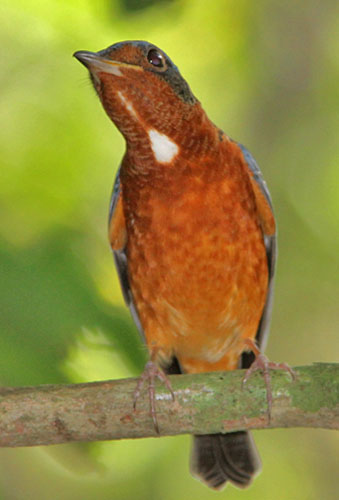 |

|
 |
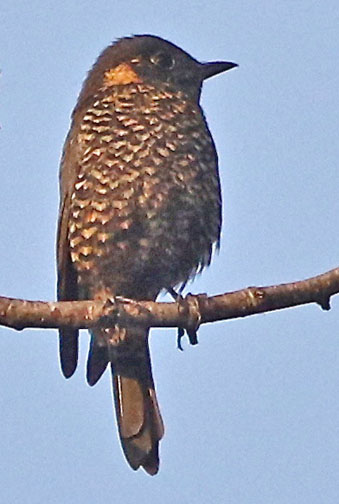 |
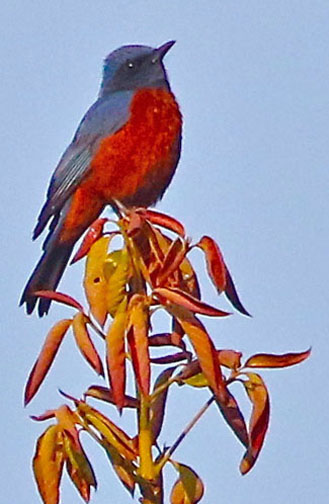 |
|
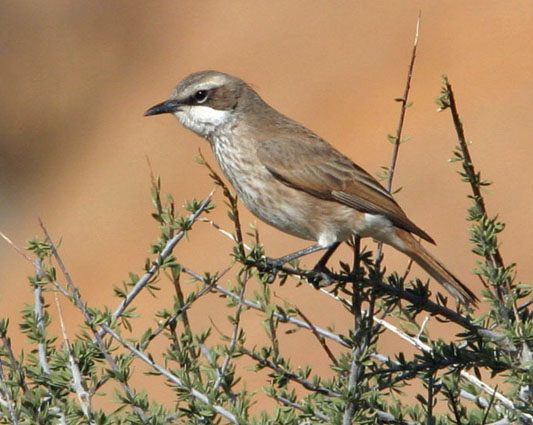 Back in the days before chats were transferred to Muscicapidae, Taylor (2006) wrote of a conundrum on the then-border between thrushes and flycatchers: "Perhaps the most difficult taxonomic problem in the family is the treatment of the monotypic African genus Namibornis. The Herero Chat-flycatcher (Namibornis herero) was discovered as recently as 1930 and occurs only in western Namibia, in extremely isolated arid regions of the escarpment and adjacent plains, and in extreme south-western Angola. It is variously described as a chat-like flycatcher, a robiin-like chat and a flycatcher-like robin. The species is often included with the chats in the family Turdidae on the basis of anatomy and feather structure, and, indeed, in terms of plumage, including that of the juvenile, proportions, voice and habitats, it dos resemble Cercomela chats such as the Familiar Chat (C. familiaris). Equally, however, it bears a superficial resemblance to Bradornis flycatchers, which it further resembles in nest structure, nest-site and eggs, as well as in the begging call of the nestling....". Back in the days before chats were transferred to Muscicapidae, Taylor (2006) wrote of a conundrum on the then-border between thrushes and flycatchers: "Perhaps the most difficult taxonomic problem in the family is the treatment of the monotypic African genus Namibornis. The Herero Chat-flycatcher (Namibornis herero) was discovered as recently as 1930 and occurs only in western Namibia, in extremely isolated arid regions of the escarpment and adjacent plains, and in extreme south-western Angola. It is variously described as a chat-like flycatcher, a robiin-like chat and a flycatcher-like robin. The species is often included with the chats in the family Turdidae on the basis of anatomy and feather structure, and, indeed, in terms of plumage, including that of the juvenile, proportions, voice and habitats, it dos resemble Cercomela chats such as the Familiar Chat (C. familiaris). Equally, however, it bears a superficial resemblance to Bradornis flycatchers, which it further resembles in nest structure, nest-site and eggs, as well as in the begging call of the nestling....".
To illustrate the problem, Taylor (2006) used my photo of Herero Chat (right), taken in remote Namibia in 2005. That was my first year with a digital camera, and it was great to see the picture in HBW.
Ten years later, Voelker et al. (2016) finally did a molecular analysis of Herero Chat, and determined that genus "Namibornis" should be dropped, but the bird was neither a Cercomela chat nor a Bradornis flycatcher. Rather, it was closest to Melaenornis flycatchers, and became Melaenornis herero. It still is a scarce, local, and little-studied species, but at least its relationships are now better resolved. There are now 10 species in genus Melaenornis, including the Northern Black-Flycatcher, widespread in the drier areas of west Africa and east Africa, south of the Sahara (below left), and the exotic Silverbird of east Africa (below right). |
|
Two muscicapids breed in North America: Northern Wheatear and Bluethroat. Northern Wheatear has populations in northern Alaska and the Yukon, Canada (race oenanthe) and a different population in eastern Canada (race leucorhoa). Population size in North America (oenanthe and leucorhoa combined) is estimated at 260,000 individuals (Dunn et al. 2020). Global population may be as high as 500 million, so North American birds account of little more than half of one percent of Northern Wheatears worldwide. Bluethroat has just a tiny breeding population in northwestern Alaska, just a tiny blip on the map in a population of up to 15 million Bluethroat (Guzy et al. 2020).
These two species are among the very few breeding passerines in North America that migrate exclusively to the Old World. Any migrants in North America south of their breeding grounds are very rare vagrants. There are just 15 records from California (I got to see one back in 1988), and all but one were in fall migration. The spring migrant was mid-June on the Farallones. The only record of Bluethroat in California was also offshore, on San Clemente I., in Sep 2008.
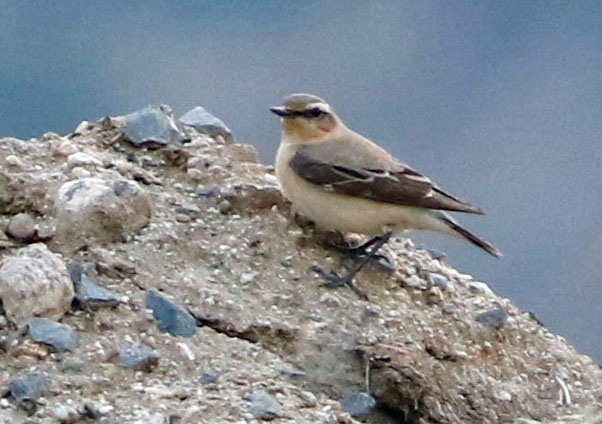 The migration of Northern Wheatear is particularly spectacular because nearly the entire global population overwinters in sub-Saharan Africa. Breeders from Alaska and the Yukon reach Africa by migrating westward across the whole of Asia and the Middle East, whereas breeders from eastern Canada make epic trans-Atlantic flights eastward. Alaskan breeding wheatears, fitted with geolocators, have been documented to fly 14,500 km (9000 mi) both ways, to and from wintering grounds in northern sub-Saharan Africa (Bairlein et al. 2012). Given these spectacularly long migration routes, it is expected that vagrants will occur. My Rockjumper tour to Bhutan in March 2019 documented the first record for Bhutan, a female in spring migration (photo left). The tour leader and I published this record (Erterius & Roberson 2019). The migration of Northern Wheatear is particularly spectacular because nearly the entire global population overwinters in sub-Saharan Africa. Breeders from Alaska and the Yukon reach Africa by migrating westward across the whole of Asia and the Middle East, whereas breeders from eastern Canada make epic trans-Atlantic flights eastward. Alaskan breeding wheatears, fitted with geolocators, have been documented to fly 14,500 km (9000 mi) both ways, to and from wintering grounds in northern sub-Saharan Africa (Bairlein et al. 2012). Given these spectacularly long migration routes, it is expected that vagrants will occur. My Rockjumper tour to Bhutan in March 2019 documented the first record for Bhutan, a female in spring migration (photo left). The tour leader and I published this record (Erterius & Roberson 2019).
Wheatears are birds of open country, and usually easy to spot. In contrast, Bluethroat is a inveterate skulker. There were a few Bluethroat at the spot in Bhutan where we found the Northern Wheatear, but no one got decent shots of them. |
|
| A male Bluethroat is a gorgeous bird. In addition, it is known to be a mimic, having been recorded mimicking more than 50 species of birds and other sounds (Guzy et al. 2020). Apparently they sit up to sing on their breeding grounds of tundra or shrubby meadows, but seeing one decently on migration is a memorable experience. My best experience was 40 years ago at some sewage ponds at the tip of the Sinai Peninsula, when I encountered a wave of Bluethroat migrants visiting a desert pool. My slides (now digitized) show two male Bluethroat, and female (above). As can be seen in this set of photos, some Bluethroats in the open will cock their tail up, and may jerk it or fan it, to expose the rufous bases of the rectrices. |
|
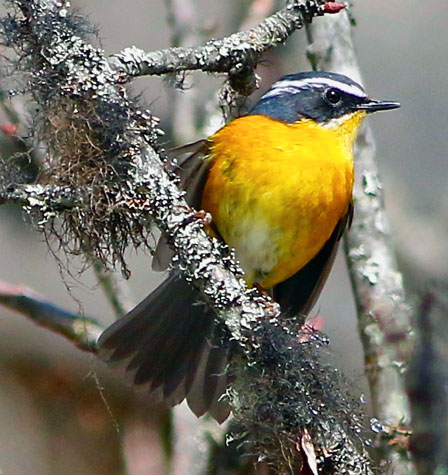 The montane forests of eastern Eurasia are the breeding ground for a bevy of beautiful male songsters, including rubythroats and redstarts. All these species migrate south, where many become almost invisible skulkers in undergrowth or scrub on migration or in winter. Among them are a singing Siberian Rubythroat (upper left above), photographed through a tiny hole in the foreground foliage; male Chinese Rubythroat (lower left above) on a song post; and White-throated Redstart, male carrying food to an unseen nest. All these digiscoped shots were from a summer trip to montane China. The redstart and Siberian Rubythroat were in a rich mixed coniferous forest in Huzu NP where we were camping at 2500m elev. (8200'). The Chinese Redstart was in alpine scrub on the Qinghai Plateau above 3,260m (10,700'). The montane forests of eastern Eurasia are the breeding ground for a bevy of beautiful male songsters, including rubythroats and redstarts. All these species migrate south, where many become almost invisible skulkers in undergrowth or scrub on migration or in winter. Among them are a singing Siberian Rubythroat (upper left above), photographed through a tiny hole in the foreground foliage; male Chinese Rubythroat (lower left above) on a song post; and White-throated Redstart, male carrying food to an unseen nest. All these digiscoped shots were from a summer trip to montane China. The redstart and Siberian Rubythroat were in a rich mixed coniferous forest in Huzu NP where we were camping at 2500m elev. (8200'). The Chinese Redstart was in alpine scrub on the Qinghai Plateau above 3,260m (10,700').
A good assortment of muscicapids undertake elevational "migrations" — rather than the long geographic migrations undertaken by wheatears and bluethroat — but moving substantial downslope and upslope movements in autumn and in spring between alpine scrub breeding habitat and wintering scrub much lower in elevation. Just one of those is White-browed Bush-Robin, shown in March at 3660m elev. (12,000'] in Bhutan (left). Here, the deciduous scrub was just starting to bud, and there was a layer of fresh snow on the ground, but the bush-robin was already patrolling a territory and singing from multiple song perches. In winter, it moves downslope into the Himalayan foothills at 2000–3000m elev. (6500-9800'), where it becomes elusive in undergrowth and bracken of wet forests.
White-browed Bush-Robin is among six species in genus Tarsiger. All of them are dedicated skulkers in migration and winter. Red-flanked Bluetail Tarsiger cyanurusis the most extensive breeder among this genus. It breeds most extensively in the taiga forest of Eurasia, and these populations undertake a lengthy migration to wintering grounds in southeast Asia. Due to that long migration, vagrants are spun off towards Europe (where there are multiple records) and recently a few have reached North America, including two that were discovered in California. One of these wintered in an urban park in downtown Los Angeles! Still, it could take hours to get even a glimpse of it among the park's ornamental hedges.
|
Another genus of skulkers of the forest floor is Larvivora. Most males in this genus are drop-dead gorgeous, as is the male Siberian Blue Robin (far right). Females are a subdued brown (near right), but both sexes have very long legs. It breeds Siberia to Japan in dense undergrowth, often near streams, and winters in the forests of southeast Asia. These shots are from a photo-blind in winter in Thailand.
Males of other Larvivora robins include the orange-headed Japanese Robin L. akahige and the red-and-black Ryukyu Robin L. komadori. Rufous-headed Robin L. ruficeps is an Endangered species breeding only in central China. It is there only mid-May to August, so where it winters is unknown (Taylor 2006). |
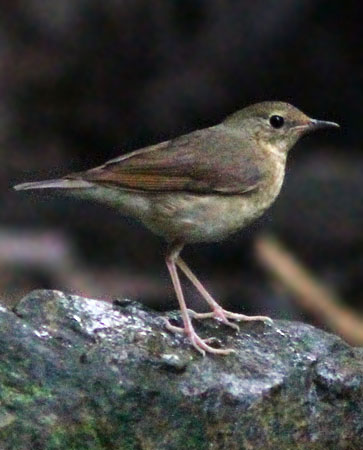 |
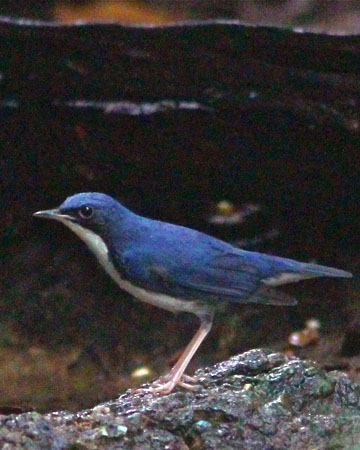 |
|
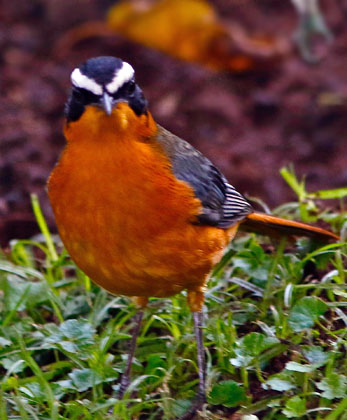 Africa also has its share of understory robins and chats, some of them very elusive and difficult to see. Forest Robin (below left) is among them, sticking close to the darkest parts of the forest floor in the Congo Basin and west African forests. It is usually located by its beautiful song. At the moment, most world checklists consider it a single species, in the monotypic genus Stiphrornis, with much geographic variation (up to 5 "Groups" in Clements' list). Yet there is published research that suggests that Forest Robin is actually comprised of at least 3 species (Boano et al. 2015, Voelker et al. 2017). Under that proposal, my photo, taken with flash on slide film in 1996 in Gabon, would be Olive-backed Forest-Robin S. pyrrholaemus. Africa also has its share of understory robins and chats, some of them very elusive and difficult to see. Forest Robin (below left) is among them, sticking close to the darkest parts of the forest floor in the Congo Basin and west African forests. It is usually located by its beautiful song. At the moment, most world checklists consider it a single species, in the monotypic genus Stiphrornis, with much geographic variation (up to 5 "Groups" in Clements' list). Yet there is published research that suggests that Forest Robin is actually comprised of at least 3 species (Boano et al. 2015, Voelker et al. 2017). Under that proposal, my photo, taken with flash on slide film in 1996 in Gabon, would be Olive-backed Forest-Robin S. pyrrholaemus.
White-starred Robin Pogonocichla stellata is also a shy and elusive understory robin within a monotypic genus. It also has much geographic variation in plumages within its range from montane east Africa to southeast Africa. It may forage at varying elevations with the forest, but in some locations is a follower of driver-ants, perching above them to snap up insects flushed by the moving swarm, just as many antbirds do around army-ant columns in South America. We were fortunate to watch this behavior in the Usambara Mts. of Tanzania.
Africa also has 14 species of robin-chats in genus Cossypha. The colorful Rüppell's Robin-Chat is shown foraging at the edge of cover, as it typical at dusk or after rains (left). It is a bird of higher-elevation forests from Ethiopia to northern Tanzania. The more widespread Cape Robin-Chat (below right) is also a montane species in east and southern Africa, even breeding to alpine scrub in South Africa. It undertakes downslope movements in winter into the lowlands. |
|
|
Not to be overlooked among the plethora of muscicapid genera are the 23 species of wheatears in genus Oenanthe. The migration of Northern Wheatear from Alaska and Canada to east Africa is discussed above, but a fair number of the Eurasian wheatears migrate long distances. Isabelline Wheatear breeds across central Eurasia and as far as the east end of the Tibetan Plateau. On the Qinghai Plateau, pairs nest at up to 4600m elev. (over 13,000'). My photo (above left) shows two just-fledged Isabelline Wheatear near Qinghai Lake, China. The species winters in Africa — mainly the Sahel zone and northeast Africa — as well as the Arabian Peninsula. If the breeders near Qinghai Lake flew to the western Sahel, that route would be well over 11,000 km (7000 miles). My first ever encounter with these elegant wheatears was in Samburu NP in north Kenya, where this wintering Isabelline Wheatear (above right) was conspicuous as it perched up on small mounds or snags in dry, heavily grazed grasslands used by zebras and wildebeests. That was in 1981, long before digital cameras, and somehow this shot ended up as quiz "N" in Sharrock's "British Birds" Mystery Photographs Book (1983).
Not all wheatears launch into such long-distance flights. Capped Wheatear (below), for example, a bird of wide-open dry grasslands, is resident in some locations in east Africa, while other populations in southern Africa move short distances in response to rainfall. |
 |
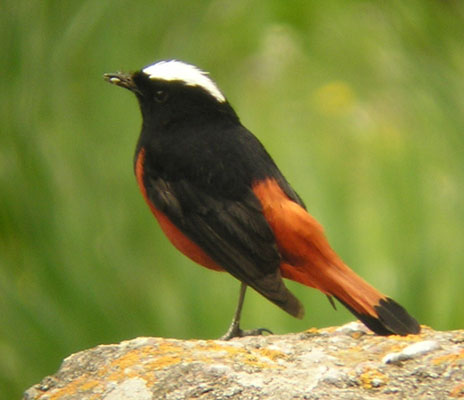 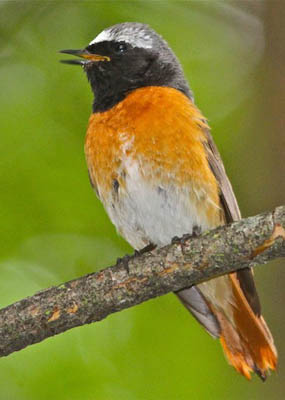 Some muscicapids frequent rushing streams, bobbing their tails, dipper-like, in rhythm to the cascade. Forktails (genus Enicurus) behave that way. So do a number of redstarts, including the colorful White-capped Water Redstart (left) of the Himalayas. So does the rare and vulnerable Luzon Redstart Phoenicurus bicolor, a Philippine endemic. Some muscicapids frequent rushing streams, bobbing their tails, dipper-like, in rhythm to the cascade. Forktails (genus Enicurus) behave that way. So do a number of redstarts, including the colorful White-capped Water Redstart (left) of the Himalayas. So does the rare and vulnerable Luzon Redstart Phoenicurus bicolor, a Philippine endemic.
There are 15 muscicapids called "redstarts," an archaic word that meant "birds with red in the tail." Centuries ago that name was given to some New World warblers (e.g., American Redstart). It is a better name for musicapids, lke Common Redstart (right), a European breeder that migrates to the Sahel region of Africa for winter.
When I visited northern China in summer, I was impressed with the variety of Phoenicurus redstarts we encountered. Shortly after that trip I posted a page on north China redstarts with photos of ten species (but not as well formatted as my newer pages). |
|
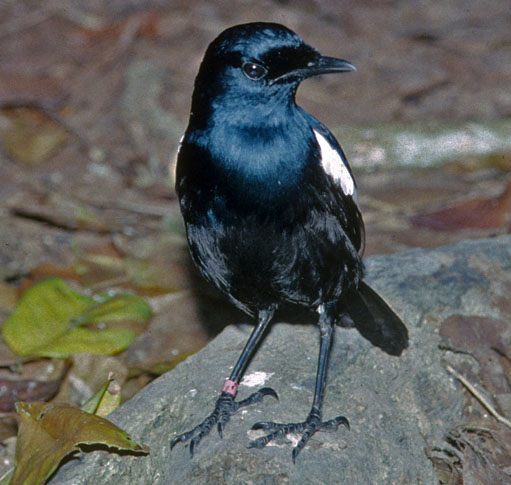 There are a dozen species in genus Copsychus, which is comprised of Indian Robin (above left), seven shamas, and three magpie-robins. All the shamas are wonderful songsters, and yet all are content to sing from perches inside the bushes and can be difficult to see. One hears many more shamas than one sees. Most shamas are long-tailed to some extent, but the champion long-tailed species is White-rumped Shama (above right). It lives in dense thickets from India to southeast Asia, and on Sumatra, Borneo, and Java. Populations in Indonesia have taken a serious dive as keeping cage birds that can sing has become widespread. This particular photo is of a shama that has just taken a bath in forest pool. There are a dozen species in genus Copsychus, which is comprised of Indian Robin (above left), seven shamas, and three magpie-robins. All the shamas are wonderful songsters, and yet all are content to sing from perches inside the bushes and can be difficult to see. One hears many more shamas than one sees. Most shamas are long-tailed to some extent, but the champion long-tailed species is White-rumped Shama (above right). It lives in dense thickets from India to southeast Asia, and on Sumatra, Borneo, and Java. Populations in Indonesia have taken a serious dive as keeping cage birds that can sing has become widespread. This particular photo is of a shama that has just taken a bath in forest pool.
Oriental Magpie-Robin Copsychus saularis is widespread in south Asia, and there are endemic species on Madagascar and the Philippines (C. albospecularis and C. mindanensis, respectively). In contrast, Seychelles Magpie-Robin is a critically Endangered species (male, right). Yet it is one of the globe's greatest recovery stories for a species at the edge of extinction.
From an estimate of 12–15 birds on Frégate I. in 1965, the
global population has been managed, with hopes of re-introducing these birds to the original range. The former range included Mahé, Praslin, La Digue, Marianne, Aride, South-east Island, St Anne and probably others, from where the species disappeared mostly between 1878 and the 1930s. Among several deleterious factors were introduced cats, introduced rats, habitat conversion and human persecution.
"In 1977–1978 some 40 Seychelles Magpie-Robins, the entire world population, survived on Frégate Island. These lived in 12 territorial groups of up to six individuals. Their range on Frégate was limited by the amount of feeding habitat, specifically bare earth and leaf litter which occurred under mature shady woodland and in cultivated vegetable gardens. By 1981 numbers there had declined to 18; an increase in the feral cat population was implicated. A successful cat eradication program was carried out and by 1983–1984 the population showed a recovery with recruitment again healthy" (Watson et al. 1992).
When we visited Frégate in 1992, only 23 were left in the wild. As you can see in the photo, the population was banded. One had to hike from the airstrip to the small forest on Frégate in which the magpie-robins were resident, but there some of the males were quite bold and tame. The most recent survey I found (2006) reported a world total of 178 bird on Frégate and on three more islands to which they've been re-introduced. If only news like this could apply on a much broader scale! |
|
 There are currently 13 species on Clements' list of genus Saxicola. Six are stonechats, six are bushchats (including Gray Bushchat atop this web page), and Whinchat Saxicola rubetra. Some have extensive migrations while those from tropical regions or islands are sedentary. The split of Siberian Stonechat (left) from European Stonechat S. rubicola was controversial but was accepted by a book focused on genus Saxicola (Urquhart & Bowley 2003), and then generally adopted globally. Siberian Stonechat breeds from European Russia to Mongolia, and migrates to wintering grounds is south and southwest Asia. Inevitably, some individuals will make errors in that journey, spinning off vagrants to far-distant lands. One even reached San Clemente I., California, in in Oct 1995. This particular vagrant imm. Siberian Stonechat (upper left, above). was on the island of Texel, off the mainland coast of the Netherlands, in October 1991. It occurred during a meeting of rarities committee members from across Europe and USA, so was documented by many sharp birders then active. There are currently 13 species on Clements' list of genus Saxicola. Six are stonechats, six are bushchats (including Gray Bushchat atop this web page), and Whinchat Saxicola rubetra. Some have extensive migrations while those from tropical regions or islands are sedentary. The split of Siberian Stonechat (left) from European Stonechat S. rubicola was controversial but was accepted by a book focused on genus Saxicola (Urquhart & Bowley 2003), and then generally adopted globally. Siberian Stonechat breeds from European Russia to Mongolia, and migrates to wintering grounds is south and southwest Asia. Inevitably, some individuals will make errors in that journey, spinning off vagrants to far-distant lands. One even reached San Clemente I., California, in in Oct 1995. This particular vagrant imm. Siberian Stonechat (upper left, above). was on the island of Texel, off the mainland coast of the Netherlands, in October 1991. It occurred during a meeting of rarities committee members from across Europe and USA, so was documented by many sharp birders then active.
White-browed Bushchat (also called Stoliczka's Bushchat) is a scarce and local endemic of dry semi-desert of the Indian subcontinent. A nice summary by Rahmani (1993) details its current status and distribution, listing 31 known localities in western India. The world population was estimated at just 2,500-10,000 birds and declining, threatened by habitat loss. The northeastern most site listed by Rahmani (1993) was Sultanpur Jheel in Haryana state. As it happens, on our first day of a private tour of India, we learned of a vagrant at Sultanpur Jheel, a short drive from Delhi. We were able to refind and document that female (middle, above). Vagrant muscicapids are great fun!
There are also island endemics among Saxicola stonechats and Bushchat, such as Réunion Stonechat (upper right, above), found only on the French island of Réunion in the equatorial Indian Ocean. |
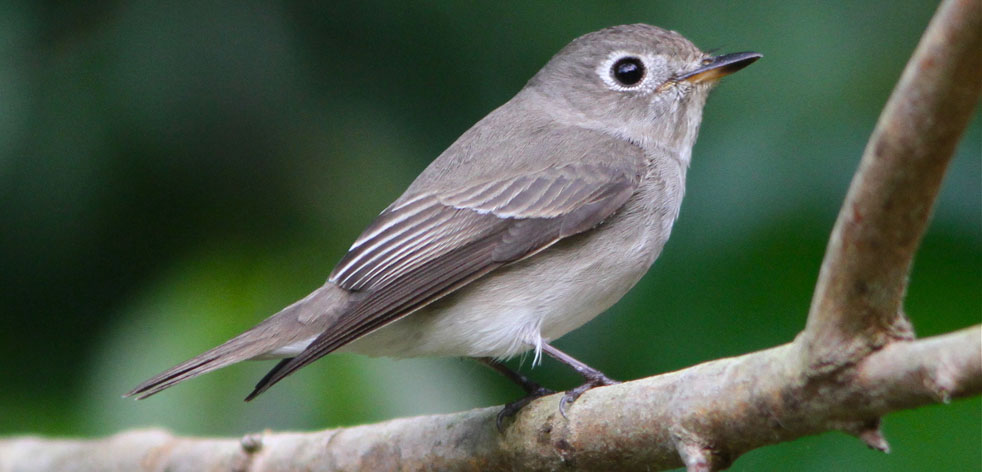 |
Finally, after 34 photos of birds in 15 genera that include robins, chats, and allies, we come to the "traditional" Muscicapidae — the set known as "Old World Flycatchers." There are 8 genera that hold 114 species of muscicapid "flycatchers." Sixteen of these are in genus Muscicapa — the genus from which the family name derives. These range from the familiar Spotted Flycatcher M. striata of Europe to the just-discovered endemic Sulawesi Brown Flycatcher M. sodhii. All are simply brown or grayish in plumage, often whitish below, and only Ferruginous Flycatcher M. ferruginea is washed with any color. A fine example is Asian Brown Flycatcher (above). It is a cute, pert, inquisitive bird, with exceedingly long primaries evolved for a substantial migration. Asian Brown migrates from nesting in northeast Asia to winter in southeast Asia.
Gray-streaked Flycatcher (near right) has perhaps the longest migration route, much of over the western Pacific Ocean. It breeds from Kamchatka and northeast China to Sakhalin and the Kuril Is., and then flies as far south as the Philippines, Borneo, Sulawesi, the Moluccas and western New Guinea to winter. At the other end of the spectrum, Swamp Flycatcher (far right) is entirely resident along sub-Saharan lakes, rivers, and papyrus swamps, across the continent from west Africa to east Africa. It is a familiar and engaging flycatcher in aquatic habitats year-round. |
 |
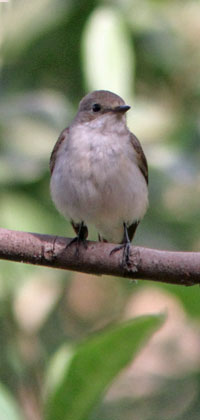 |
|
|
| The most speciose genus in the entire family is the Ficedula flycatchers. There are beautifully colored examples among the 34 rather small species. Two of my favorites are males of Mugimaki Flycatcher (above left) and Slaty-backed Flycatcher (above right). These are both migratory birds of east Asia that I happened to encounter in winter. Mugimaki was seen only because bird photographers had habituated this male to meal-worms, provided during weekends at Khao Yai NP, where the city dwellers went on the weekend to avoid the summer heat of lowland Bangkok. Our visit was (intentionally) on a week-day, but the little flycatcher flew in to check us out anyway. I was enchanted to see the combination of a short tail and long wings on such a cute little bird. The long wings are consistent with its long migration route from Siberia to southeast Asia to the Philippines and Sulawesi. The name "mugimaki" comes from Japanese and means "wheat-sower." The Slaty-backed was shy and elusive inside the canopy of the Nameri forest in Assam, India. It breeds in central China and winters in northeast India. Both flycatchers had bold colors for such small birds. |
 Another colorful example in Ficedula flycatchers is Green-backed Flycatcher (left; initially known as Elisa's Flycatcher or Chinese Narcissus Flycatcher. For quite some time, most checklists considered a subspecies of Narcissus Flycatcher Ficedula narcissina of Japan. The photo is of a male of the taxon elisae, an endemic breeder to east China. At the same location in China as this bird, our group (led by Paul Holt) also saw several "Peking Flycatcher F. beijingnica" (Zheng et al. 2000) which is actually the first-summer male of F. elisae. In each case the "Peking" responded vigorously to the song of elisae, essentially proving they are the same species. Dickinson (2003) wisely does not consider "beijingnica" even a subspecies; he simply lumps it with elisae stating that "critical acoustic information is missing" from Zheng et al. (2000) and "the description might apply to a subadult form of elisae (which is exactly the case!). Paul Holt was in the forefront of getting this sorted out. Another colorful example in Ficedula flycatchers is Green-backed Flycatcher (left; initially known as Elisa's Flycatcher or Chinese Narcissus Flycatcher. For quite some time, most checklists considered a subspecies of Narcissus Flycatcher Ficedula narcissina of Japan. The photo is of a male of the taxon elisae, an endemic breeder to east China. At the same location in China as this bird, our group (led by Paul Holt) also saw several "Peking Flycatcher F. beijingnica" (Zheng et al. 2000) which is actually the first-summer male of F. elisae. In each case the "Peking" responded vigorously to the song of elisae, essentially proving they are the same species. Dickinson (2003) wisely does not consider "beijingnica" even a subspecies; he simply lumps it with elisae stating that "critical acoustic information is missing" from Zheng et al. (2000) and "the description might apply to a subadult form of elisae (which is exactly the case!). Paul Holt was in the forefront of getting this sorted out.
The taxonomy of many other Ficedula flycatchers is much less complicated. Most, however, are not nearly so colorful and are patterned in shades of grayish, brownish, and whitish.
Yet another set of Old World flycatcher that are colorful — this time feathered in shades of blue — are the genera Cyanoptila (including Blue-and-white Flycatcher C. cyanomelania) and most of the six species of Eumyias. I very much like this photo from Bhutan of a blue bird against a blue sky. The bird is the Himalayan breeding Verditer Flycatcher. It moves downslope in migration to winter as far south as south India and central Thailand. |
 |
 |
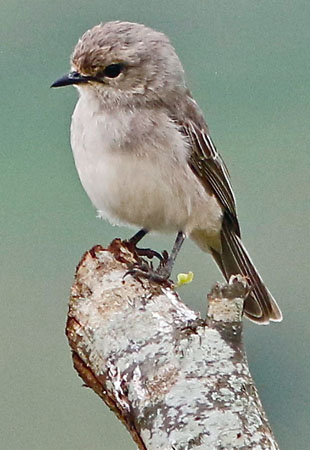 |
Less esoteric are 16 rather plain African species in genera Agricola, Bradornis, and Fraseria. The latter are primarily forest species; this is Tessmann's Flycatcher (above) of the mid-and-upper canopy of lowland forests in west Africa.
A common flycatcher of east African thornscrub is what I prefer to call Grayish Flycatcher (left). In African books it is called Gray Flycatcher but there is another "Gray Flycatcher" in North America, and neither the AOS (in North America) nor African authorities have added a prefix, so we have the intolerable situation of two unrelated flycatchers bearing the same name. Using the name Grayish Flycatcher solves the problem.
There are 30 species in genus Cyornis. Most are various "blue-flycatchers," named for upperparts of males, as females are mostly brown. Some have orange breasts, like Indochinese Blue Flycatcher (male, right). But the genus now includes most of the plain-colored "jungle-flycatchers." There have been many taxonomic changes in Cyornis recently. |
 |
|
 We've almost ignored behavior in this short summary, but I've encountered odd and interesting behaviors occasionally, including these displaying Northern Anteater-Chat (right). This family group was calling and displaying on the floor of Ngorongoro Crater. It is said to be co-operative breeding, presumably with some of last year's young helping at the nest, and perhaps this is a communal display cementing those bonds? Not much is known, I guess. Also not much is known about Congo Moorchat (below), surveying its territory in open plains of southeaster Gabon from the top of a "toadstool" termite mound. We've almost ignored behavior in this short summary, but I've encountered odd and interesting behaviors occasionally, including these displaying Northern Anteater-Chat (right). This family group was calling and displaying on the floor of Ngorongoro Crater. It is said to be co-operative breeding, presumably with some of last year's young helping at the nest, and perhaps this is a communal display cementing those bonds? Not much is known, I guess. Also not much is known about Congo Moorchat (below), surveying its territory in open plains of southeaster Gabon from the top of a "toadstool" termite mound. 
|
 I would be remiss to overlook the six niltavas (genus Niltava) and the 8 shortwings (two genera). All are highly sought species because of their beauty and their elusiveness. All are primarily birds to humid evergreen forest in the mountains of Asia and major islands. Most of the species have deep blue plumage; some have chestnut bellies. The brilliance of the lustrous indigo-blue color of a male Small Niltava, with its glittering highlights and blue shoulder bar, can be breathtaking (photo right). It is a Himalayan bird, frequenting edges and shrubberies in broadleaf evergreen forests, and then moving downslope to the foothills in winter. I would be remiss to overlook the six niltavas (genus Niltava) and the 8 shortwings (two genera). All are highly sought species because of their beauty and their elusiveness. All are primarily birds to humid evergreen forest in the mountains of Asia and major islands. Most of the species have deep blue plumage; some have chestnut bellies. The brilliance of the lustrous indigo-blue color of a male Small Niltava, with its glittering highlights and blue shoulder bar, can be breathtaking (photo right). It is a Himalayan bird, frequenting edges and shrubberies in broadleaf evergreen forests, and then moving downslope to the foothills in winter.
The Large Niltava (a distant shot just below) is similar but twice the size of Small Niltava. It is the largest Asian muscicapid and is nearly the size of Varied Thrush (of North America) or Scaly Thrush (in Eurasia). It may sing from song-posts high in the canopy, at elevations of 2000m (>6000') or more.
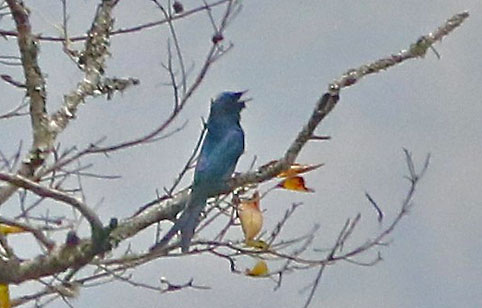
The shortwings, like niltavas, are often deep shiny blue and are lovely songsters. The shortwings are even more elusive to see, living in impenetrable thickets in the understory of montane forests. Great Shortwing Heinrichia calligyna is a Sulawesi endemic. I have seen it, but doing so took much effort. There are 7 species of Brachypteryx shortwings inhabiting the mountains in south Asia, Taiwan, Philippines, and Greater Sundas. Despite their often dark-blue color, they look dark in the shadows, and are small, ground-hugging, rather dumpy birds, more often heard than seen.
The Muscicapidae is a huge family of interesting birds — migrants and non-migrants, colorful and plain, some widespread and some very rare — and we've touched on only about half of the genera in the family. We must end somewhere, so here's a couple more random muscicapids. Spotted Morning-Thrush (below left) is a large, ground-loving, distinctive passerine in east Africa, living in a variety of thicket or scrubby habitats. It is generally quite shy, but sometimes adapts to humans in game-parks (where this photo was taken). It forages on the ground, either in the undergrowth or in the open, often with much wing-flicking and tail-cocking. Two other species in genus Cichladusa reside in palm thickets and are called palm-thrushes.
In the right-hand column, the first bird is a member of genus Cercotrichas: Rufous-tailed Scrub-Robin (below, upper right). It is actually a member of the African population that breeds in brushy country just south of the Sahara, including the Sahel, and until recently was considered its own species, African Scrub-Robin (C. minor). The photo documents one of the few records for Gabon, near the White Volta River in the far north. The nominate race of Rufous-tailed Scrub-Robin breeds from southern Spain and Morocco to the Middle East, and migrates to the Sahel, the lower Nile, and the Red Sea. There are ten species of scrub-robins in Cercotrichas. One other occurs in Africa and the Middle East, the remaining species are African continental endemics. I should also mention the African endemics known as alethes (6 species in genera Alethe & Chamaetylas) and akalats (genus Sheppardia). Like the Forest Robin discussed above, these are all secretive, ground-loving, shy birds of the forest understory in a variety of dense woodlands, from the Congo Basin to isolated mountain ranges (e.g., Usambara Akalat S. montana). They are all small birds patterned in variations of brown, rufous, gray or white. So far I've seen two akalats (briefly) and four alethes (including a pair at an ant-swarm), but always in dark, dingy, understory conditions (I've not pointed a camera at any).
I conclude the page with another Enicurus forktail — the very dapper Slaty-backed Forktail, seen here (bottom right) resting briefly on a log over a Thai river. It has a wide range in the Himalayas and southeast Asia, but tends to be present locally in low numbers. Like many forktails, it is skittish around people. |
|
| |
Photos: The Gray Bushchat Saxicola ferreus was at Yongkola, Bhutan, in 21 Mar 2019. The White-crowned Forktail Enicurus leschenaulti was along the river at Huayng, China, on 8 Nov 2010. The European Robin Erithacus rubecula was singing in the Vondelpark, Amsterdam, the Netherlands, on 7 July 2013. The Familiar Chat Oenanthe familiaris was at Augrabies NP, South Africa, on9 July 2005. The Hodgdon's Redstart Phoenicurus hodgsoni was at Yongkola, Bhutan, on 21 Mar 2019. The Mountain Wheatear Myrmecocichla monticola ["Mountain Chat" colloquially] was at Grosse Spitzkoppe Nature Reserve, Namibia, on 17 July 2005. The Blue Whistling-Thrush Myophonus caeruleus was near Trongsa, Bhutan, on 26 Mar 2019. The White-throated Rock-Thrush Monticola gularis was in Khao Yai NP, Thailand, on 25 Dec 2012. The Blue-capped Rock-Thrush Monticola cinclorhyncha was along Trongsa Rd., Bhutan, on 27 Mar 2019. The male and female Chestnut-bellied Rock-Thrush Monticola rufiventris were in the Morong forest, Bhutan, on 19 Mar 2019. The Herero Chat Melaenornis herero was at Grosse Spitzkoppe Nature Reserve, Namibia, on 17 July 2005. The Northern Black-Flycatcher Melaenornis edolioides was in Mole NP, Ghana, on 13 Dec 2013. The Silverbird Melaenornis semipartitus was in Tarangire NP, Tanzania, on 9 June 2018. The female Northern Wheatear Oenanthe oenanthe was the first record for Bhutan at Wangdue on 30 March 2019. The 3 migrant Bluethroat Luscinia svecica were at sewage ponds at Sharm-el-Sheik, Sinai, on 5 Nov 1981. The singing male Siberian Rubythroat Calliope calliope and the food-carrying male White-throated Redstart Phoenicurus schisticeps were both in Huzu Bei Shan NP, Qinghai, China, on 23 June 2004. The male Himalayan Rubythroat Calliope pectoralis was on the Qinghai Plateau, China, on 29 June 2004. The male White-browed Bush-Robin Tarsiger indicus was at Thruming La pass, Bhutan, on 4 Mar 2019. The female and male Siberian Blue Robin Larvivora cyane were photographed from a photo-blind near Kaeng Krachan NP, Thailand, on 20 Dec 2012. The male Rüppell's Robin-Chat Cossypha semirufa was at Gibbs Farm, Arusha, Tanzania, on 10 June 2018. The Forest Robin Stiphrornis erythrothorax was on the forest floor in La Lopé Reserve, Gabon, on 6 July 1996.. The Cape Robin-Chat Cossypha caffra was at Müller's Resort in the East Usambara Mts., Tanzania, on 5 June 2018. The two fledgling Isabelline Wheatear Oenanthe isabellina were near Qinghai Lake, China, on 18 June 2004, and the adult was in Samburu NP, Kenya, in Nov 1981. The Capped Wheatear Oenanthe pileata was on the Engikaret plains, Arusha, Tanzania, on 7 June 2018. The White-capped Water Redstart Phoenicurus leucocephalus was along a river in Huzu Bei Shan NP, Qinghai, China, on 22 June 2004. The male Common Redstart Phoenicurus phoenicurus was singing at Oslo, Norway, on in March 2007. The Indian Robin Copsychus fulicatus was at Ramnagar, India, in March 2001. The male White-rumped Shama Copsychus malabaricus was shot from a photo-blind near Kaeng Krachan NP, Thailand, on 20 Dec 2012. The banded male Seychelles Magpie-Robin Copsychus sechellarum was on Frégate Is., Seychelles, on 11 Nov 1992. The large photo of Siberian Stonechat Saxicola maurus was at Khao Yai NP, Thailand, on 25 Dec 12; the fall vagrant Siberian Stonechat was at Texel, the Netherlands, on 15 Oct 1991 (the record was accepted by the Dutch Rarities Committee). The female White-browed Bushchat Saxicola macrorhyncha was at Sultanpur Jheel 11 Mar 2001. The Réunion Stonechat Saxicola tectes was high up the central volcano above Brulé, Réunion Island, on 4 Dec 1992. The Asian Brown Flycatcher Muscicapa dauurica was at Khao Yai NP, on 26 Dec 2012. The Gray-streaked Flycatcher Muscicapa griseisticta was at Dumoga-Bone (Bogani Nani Wartabone) NP on 4 Oct 2011. The Swamp Flycatcher Muscicapa aquatica was in Mole NP, Ghana, on 13 Dec 2013. The male Mugimaki Flycatcher Ficedula mugimaki was at Khao Yai NP, on 25 Dec 2012. The male Slaty-backed Flycatcher Ficedula erithacus was in Nameri NP, Assam, India, on 15 Mar 2019. The male Green-backed [Elisa's] Flycatcher Ficedula elisae was at Wulingshan, Hebei Province, China, on 9 June 2004. The male Verditer Flycatcher Eumyias thalassinus was along Zhemgang Rd., Bhutan, on 21 Mar 2019. The Tessmann's Flycatcher Fraseria tessmanni was in the Nsutu Forest, Ghana, on 5 Dec 2012. The Grayish [African Gray] Flycatcher Bradornis microrhynchus was at "Anthony's spot," east of Mwanga, Tanzania, on 1 Jun 2018. The male Indochinese Blue Flycatcher Cyornis sumatrensis rubecula was near Kaeng Krachan NP, Thailand, on 20 Dec 2012. The displaying group of Northern Anteater-Chat Myrmecocichla aethiops was in Ngorongoro Crater NP, Tanzania, on 11 June 2018. The Congo Moorchat Myrmecocichla tholloni was on the Batéké Plateau, Gabon, on 10 July 1996. The male Small Niltava Niltava macgrigoriae was in the Morong forest, Bhutan, on 18 Mar 2019. The singing male Large Niltava Niltava grandis was along Lingmethang Rd., Bhutan, on 22 Mar 2018. The Spotted Morning-Thrush Cichladusa guttata was at Lake Manyara NP, Tanzania, on 7 Aug 2002. The Rufous-tailed Scrub-Robin Cercotrichas galactotes minor was near Sapelinga, Ghana, on 15 Dec 2013. The Slaty-backed Forktail Enicurus schistaceus was at Khao Yai NP, on 25 Dec 2012.
All photos © Don Roberson; all rights reserved.
Family Book: Rating 
Clement, Peter. 2015. Robins and Chats. Illustrated by Chris Rose. Helm Identification Guide. Bloomsbury Publ., London.
I was able to get a superficial overview of this handbook, part of the Helm Identification Guides series, on-line (in Amazon and elsewhere), but I don't actually own this book, nor have I studied it in details. It covers the world's 170 species of robins, chats, and relatives, which had one time been considered part of the thrush family, Turdidae. It was initially intended to be the second volume on Thrushes, so the decision of what would be in the author's first volume — called Thrushes and published in 2000 (by Princeton Univ. Press) — was made in the 1990s. Since then, the vast majority of this book are robins, chats, and allies that are now assigned to a separate family [Muscicapidae], together with the Old World flycatchers. According, this volume includes North American bluebirds, Asian cochoas, and Bornean fruit-hunter — all of these are thrushes in the Turdidae. In addition, it leaves out rock-thrushes and whistling thrushes, which were covered in Thrushes (2000). So one needs part of the Thrushes volume to even have a complete set of muscicapid "robins and chats." There is no volume for the actual Old World Flycatchers.
The book discusses the identification and habits of these birds on a species-by-species basis, after substantial research, with range maps, more than six hundred color photographs that illustrate age and racial plumage differences, and 64 fine color plates by artist Chris Rose. I like the plates but too many of the photographs are published as small sizes in which details are hard to see. The maps are detailed and look accurate and some species have separate maps for breeding/wintering grounds or different subspecies groups (i.e.. Common Stonechat), but the range of passage migrants is not shown. The taxonomy is conservative — e.g., retaining Common Stonechat as one huge species — but the relevant taxa are discussed in detail, as subspecies. Overall a fine book, although pricey, that holds up the Helm series standard very nicely.
As noted, because Robins & Chats does not cover all the "non-flycatcher" muscicapids, one finds them in Peter Clement's earlier book on Thrushes. I repost below parts of the review written in 2004 about that volume, and have added a few extra comments. It is interesting that Clement (2000) discusses the concept that he intends the books on thrushes and muscicapids to be a "two volume" approach. As the overall project began in 1990, it took 25 years, and two different publishers, to complete.
Family book: Rating 
Clement, Peter. 2000. Thrushes. Illustrated by Ren Hathway. Princeton Univ. Press, Princeton, N. J.
This is an excellent addition to the family books in the Princeton series. [Full disclosure: I commented on a couple species account during the draft stage, and I'm acknowledged in the book.] The plates appear separately near the front: the artwork, by Ren Hathway, is rather good in a "field guide" style, although some show welcome background details, opposite summary pages which include small maps. The maps I looked at were quite good. Distinct races are nicely covered. The text cover identification, habitat, breeding biology (very summarized), relationships, and detailed plumage descriptions, plus references which (in contrast to some similar efforts) look reasonably extensive. I don't personally see the need for the detailed plumage descriptions since no book like this can hope to cover the complete range of variation, and they are very tedious to read, but it is the "style" of these family books. There are some helpful extra sketches of plumage details scattered in the text.
I was very impressed by the introductory material. Clement goes into detail about the taxonomic questions that arise in this group, and details each genera in a thorough manner. I like his clear discussion of the choices that he made, although I disagree with some Anglo-centric choices for English names.
A disappointing point was the decision not to include several genera of 'true' thrush (such as the bluebirds and Fruithunter). It is stated that they are to be included in a companion book but that tome is not yet published, and who knows when and if it will be. I would have preferred to have all the Turdidae in this authoritative book.
Update: From may perspective some 20 years later, the book still has a good feel to it, and it is very comparably with the author's Robins & Chats (2015). It covers 13 species of rock-thrushes and 7 species of whistling-thrushes — all now assigned to Muscicapidae, and (of course) is still missing bluebirds and Fruithunter.
Despite the two volumes by Peter Clemens — Thrushes (2010) & Robins and Chats (201) — there is no "family book" on the entire 300+ species in today's Muscicapidae. It takes two accounts (those on thrushes and Old World flycatchers) in the Handbook of the Birds of the World series, but together a fine introduction to the entire family, with some outstanding photos, is presented by Collar (2005) and Taylor (2006). In addition, the focus by Urquhart & Bowley (2003) on the 16 stonechats and bushchats in the genus Saxicola, is very thorough. It is also in the Helm series.
Literature cited:
Barker, F.K., A. Cibois, P. Schikler, J. Feinstein, and J. Cracraft. 2004. Phylogeny and diversification of the largest avian radiation. Proc. Nat. Acad. Sci. 101: 11040-11045.
Bairlein, F., D.R. Norris, R. Nagel, M. Multe, C.C. Voigt, J.W. Fox, D.J.T. Hussell, and H. Schmaljohann. 2012. Cross-hemisphere migration of a 25 g songbird. Biology Letters 8: 505–507.
Boano, G., N. Vinals, A. Durante, and M. Pavia. 2015. Apparent sympatry of Stiphrornis pyrrholaemus Schmidt & Angehr, 2008 and S. xanthogaster Sharpe, 1903 (Passeriformes: Muscicapidae) in Gabon, and taxonomic implications. Zootaxa 4032: 127–133.
Collar, N.J. 2005. Family Turdidae (Thrushes), pp. 514–807 in Handbook of the Birds of the World (del Hoyo, J., A. Elliott & D.A. Christie, eds). Vol. 10. Lynx Edicions, Barcelona, Spain.
Collar, N.J., M.J. Crosby, and A.J. Stattersfield. 1994. Birds to Watch 2: The World List of Threatened Birds. BirdLife Conservation Series No. 4. BirdLife International, Cambridge, England.
Dunn, E. H., D. J. T. Hussell, J. Kren, and A. C. Zoerb. 2020. Northern Wheatear (Oenanthe oenanthe), ver. 2.0. in Birds of the World (P. G. Rodewald, B. K. Keeney, and S. M. Billerman, eds). Cornell Lab Ornith., Ithaca, N.Y.
Erterius, D., and D. Roberson. 2019. Northern Wheatear Oenanthe oenanthe in Bhutan. Indian Birds 15 (3): 96–97.
Guzy, M J., B.J. McCaffery, and N. Collar. 2020. Bluethroat (Luscinia svecica), ver. 1.0. in Birds of the World (S.M. Billerman, ed.). Cornell Lab Ornith., Ithaca, NY
Keith, S., E.K. Urban, and C.H. Fry, eds. 1992. The Birds of Africa. Vol. 4: Broadbills to Chats. Academic Press, London & New York.
Mayr, E., and D. Amadon. 1951. A classification of recent birds. Amer. Mus. Novitates 1946: 453–473.
McCulloch, N. 1996. The Seychelles Magpie Robin: first steps on the road to recovery. Bull. African Bird Club 3: 81-84.
Outlaw, R.K., G. Voelker, and D.C. Outlaw. 2007. Molecular systematics and historical biogeography of the rock-thrushes (Muscicapidae: Monticola). Auk 124: 561–577.
Outlaw, R.K., G. Voelker, and R.C.K. Bowie. 2010. Shall we chat? Evolutionary relationships in the genus Cercomela (Muscicapidae) and its relation to Oenanthe reveals extensive polyphyly among chats distributed in Africa, India and the Palearctic. Molec. Phylog. Evol. 55: 284–292.
Rahmani, A.R. 1993. Little-known bird: White-browed Bushchat. Oriental Bird Club Bull. 17:28-30.
Sangster, G., P. Alström, E. Forsmark, and U. Olsson. 2010. Multi-locus phylogenetic analysis of Old World chats and flycatchers reveals extensive paraphyly at family, subfamily and genus level (Aves: Muscicapidae). Molec. Phylog. Evol. 57: 380–392.
Sharrock, J.T.R. 1983. The 'British Birds' Mystery Photographs Book. British Birds, Biggleswade, England.
Sibley, C.G., and J.E. Ahlquist. 1990. Phylogeny and Classification of Birds: a Study of Molecular Evolution. Yale Univ. Press, New Haven, CT.
Taylor, P.B. 2006. Family Muscicapidae (Old World Flycatchers), pp. 56–162 in Handbook of the Birds of the World (del Hoyo, J., A. Elliott & D.A. Christie, eds). Vol. 11. Lynx Edicions, Barcelona, Spain.
Urban, E.K., C.H. Fry, and S. Keith, eds. 1997. The Birds of Africa. Vol. 5. Academic Press, London.
Urquhart, E., and A. Bowley. 2003. Stonechats: A Guide to the Genus Saxicola. Yale Univ. Press, New Haven, CT.
Voelker, G., J.W. Huntley, J.V. Peñalba, and R.C.K. Bowie. 2016. Resolving taxonomic uncertainty and historical biogeographic patterns in Muscicapa flycatchers and their allies, Molec. Phylog. Evol. 94: 618–625.
Voelker, G., and G.M. Spellman. 2004. Nuclear and mitochondrial DNA evidence of polyphyly in the avian superfamily Muscicapoidea. Molec. Phylog. Evol. 30: 386–394.
Voelker, G., M. Tobler, H.L. Prestridge, E. Duijm, D. Groenenberg, M.R. Hutchinson, A.D. Martin, A. Nieman, C.S. Roselaar, and J.W. Huntley. 2017. Three new species of Stiphrornis (Aves: Muscicapidae) from the Afro-tropics, with a molecular phylogenetic assessment of the genus. Syst. & Biodivers. 15: 87–122.
Watson, J., C. Warman, D. Todd, and V. Laboudallon. 1992. The Seychelles magpie robin Copsychus sechellarum: ecology and conservation of an endangered species. Biol. Conserv. 61: 93–106.
Wetmore, A. 1960. A classification of the birds of the world. Smithsonian misc. coll. 139 (11), Smithsonian Institution, Washington, D. C.
Wink, M., H. Sauer-Gürth, and E. Gwinner. 2002. Evolutionary relationships of stonechats and related species inferred from mitochondrial-DNA sequences and genomic fingerprinting. Brit. Birds 95: 349–355.
Zheng, G., Song, Zhang, Zhang, and Guo. 2000. A new species of flycatcher (Ficedula) from China. J. Beijing Normal Univ. (Nat. Sci.) 36: 405–409.
Zuccon, D., and P.G.P. Ericson. 2010a. The Monticola Rock-Thrushes: Phylogeny and biogeography revisited. Molec. Phylog. Evol. 55: 901–910.
Zuccon, D., and P.G.P. Ericson. 2010b. A multi-gene phylogeny disentangles the chat-flycatcher complex (Aves: Muscicapidae). Zool. Scripta 39: 213–224.
|
|
|


 Back in the days before chats were transferred to Muscicapidae, Taylor (2006) wrote of a conundrum on the then-border between thrushes and flycatchers: "Perhaps the most difficult taxonomic problem in the family is the treatment of the monotypic African genus Namibornis. The Herero Chat-flycatcher (Namibornis herero) was discovered as recently as 1930 and occurs only in western Namibia, in extremely isolated arid regions of the escarpment and adjacent plains, and in extreme south-western Angola. It is variously described as a chat-like flycatcher, a robiin-like chat and a flycatcher-like robin. The species is often included with the chats in the family Turdidae on the basis of anatomy and feather structure, and, indeed, in terms of plumage, including that of the juvenile, proportions, voice and habitats, it dos resemble Cercomela chats such as the Familiar Chat (C. familiaris). Equally, however, it bears a superficial resemblance to Bradornis flycatchers, which it further resembles in nest structure, nest-site and eggs, as well as in the begging call of the nestling....".
Back in the days before chats were transferred to Muscicapidae, Taylor (2006) wrote of a conundrum on the then-border between thrushes and flycatchers: "Perhaps the most difficult taxonomic problem in the family is the treatment of the monotypic African genus Namibornis. The Herero Chat-flycatcher (Namibornis herero) was discovered as recently as 1930 and occurs only in western Namibia, in extremely isolated arid regions of the escarpment and adjacent plains, and in extreme south-western Angola. It is variously described as a chat-like flycatcher, a robiin-like chat and a flycatcher-like robin. The species is often included with the chats in the family Turdidae on the basis of anatomy and feather structure, and, indeed, in terms of plumage, including that of the juvenile, proportions, voice and habitats, it dos resemble Cercomela chats such as the Familiar Chat (C. familiaris). Equally, however, it bears a superficial resemblance to Bradornis flycatchers, which it further resembles in nest structure, nest-site and eggs, as well as in the begging call of the nestling....".



 The Muscicapidae is a huge family of smallish Old World passerines that includes not only many of the "flycatchers" of the Old World, but also a large number of "robins,""chats," and "bushchats," of which Gray Bushchat (left), a widespread roadside bird in the Himalayan foothills, is just one example. Other examples are the Old World redstarts, stonechats, shamas, forktails, wheatears, alethes, akalats, rock-thrushes, whistling-thrushes, shortwings, niltavas, and a large assortment of Old World flycatchers. Together, it might be best to think of them as "muscicapids," although, frankly, given the fact that American checklists and many handbooks (e.g., Taylor 2006) label them as "Old World flycatchers," that is what I tend to call them. The assortment of birds in this family is staggering. The forktails, residing along rushing streams in Eurasia, are gorgeous in black-and-white, as they bob in rhythm to raging water than surround them; an example is White-crowned Forktail (below).
The Muscicapidae is a huge family of smallish Old World passerines that includes not only many of the "flycatchers" of the Old World, but also a large number of "robins,""chats," and "bushchats," of which Gray Bushchat (left), a widespread roadside bird in the Himalayan foothills, is just one example. Other examples are the Old World redstarts, stonechats, shamas, forktails, wheatears, alethes, akalats, rock-thrushes, whistling-thrushes, shortwings, niltavas, and a large assortment of Old World flycatchers. Together, it might be best to think of them as "muscicapids," although, frankly, given the fact that American checklists and many handbooks (e.g., Taylor 2006) label them as "Old World flycatchers," that is what I tend to call them. The assortment of birds in this family is staggering. The forktails, residing along rushing streams in Eurasia, are gorgeous in black-and-white, as they bob in rhythm to raging water than surround them; an example is White-crowned Forktail (below). The taxonomic history of this group is checkered with uncertainties and contradictions. Well-known European species such as Common Nightingale Luscinia megarhynchos and European Robin (singing male, right) were within this group, but all were once considered a part of a huge group including thrushes, Old World warblers, babblers and allies (Mayr and Amadon 1951). Later the grouping was restricted but still included the batises, monarchs, and whistlers (Wetmore 1960) that are now known to be unrelated, separate families. Sibley & Ahlquist (1990) created a huge Muscicapidae with two subfamilies: the 'true thrushes" and than all the rest, which were divided into two tribes, the "chats" and the Old World flycatchers. Thereafter, for a time, the standard view evolved that there were basically two families formed by this assemblage: the Thrushes [Turdinae] included thrushes, Old World robins, various Old World chats, and wheatears, on the one hand, and the "Old Word Flycatchers" isolated in the Muscicapidae (e.g., Taylor 2006).
The taxonomic history of this group is checkered with uncertainties and contradictions. Well-known European species such as Common Nightingale Luscinia megarhynchos and European Robin (singing male, right) were within this group, but all were once considered a part of a huge group including thrushes, Old World warblers, babblers and allies (Mayr and Amadon 1951). Later the grouping was restricted but still included the batises, monarchs, and whistlers (Wetmore 1960) that are now known to be unrelated, separate families. Sibley & Ahlquist (1990) created a huge Muscicapidae with two subfamilies: the 'true thrushes" and than all the rest, which were divided into two tribes, the "chats" and the Old World flycatchers. Thereafter, for a time, the standard view evolved that there were basically two families formed by this assemblage: the Thrushes [Turdinae] included thrushes, Old World robins, various Old World chats, and wheatears, on the one hand, and the "Old Word Flycatchers" isolated in the Muscicapidae (e.g., Taylor 2006). 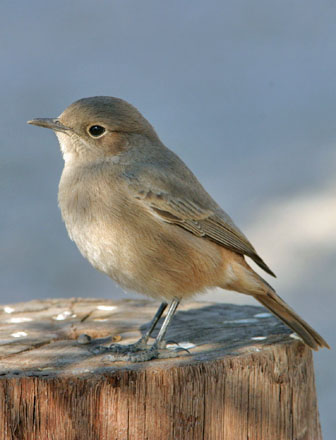
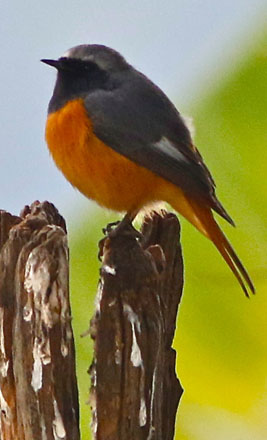
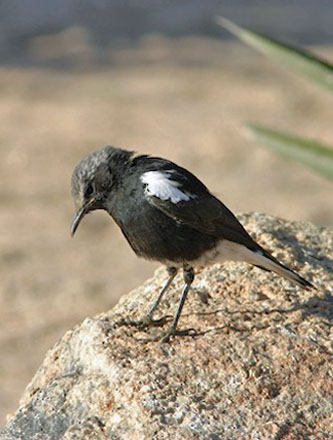





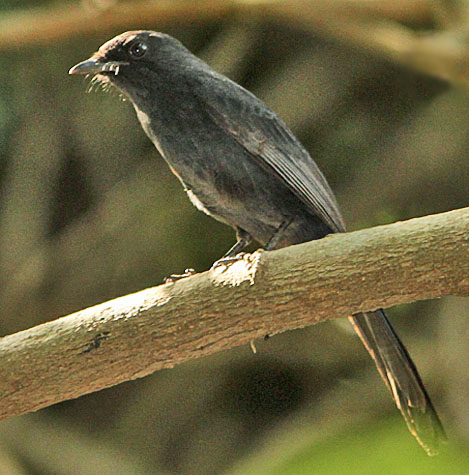
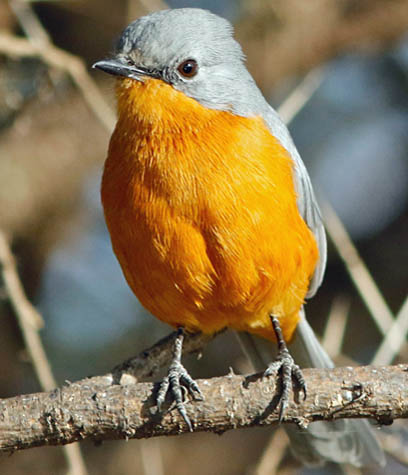
 The migration of Northern Wheatear is particularly spectacular because nearly the entire global population overwinters in sub-Saharan Africa. Breeders from Alaska and the Yukon reach Africa by migrating westward across the whole of Asia and the Middle East, whereas breeders from eastern Canada make epic trans-Atlantic flights eastward. Alaskan breeding wheatears, fitted with geolocators, have been documented to fly 14,500 km (9000 mi) both ways, to and from wintering grounds in northern sub-Saharan Africa (Bairlein et al. 2012). Given these spectacularly long migration routes, it is expected that vagrants will occur. My Rockjumper tour to Bhutan in March 2019 documented the first record for Bhutan, a female in spring migration (photo left). The tour leader and I published this record (Erterius & Roberson 2019).
The migration of Northern Wheatear is particularly spectacular because nearly the entire global population overwinters in sub-Saharan Africa. Breeders from Alaska and the Yukon reach Africa by migrating westward across the whole of Asia and the Middle East, whereas breeders from eastern Canada make epic trans-Atlantic flights eastward. Alaskan breeding wheatears, fitted with geolocators, have been documented to fly 14,500 km (9000 mi) both ways, to and from wintering grounds in northern sub-Saharan Africa (Bairlein et al. 2012). Given these spectacularly long migration routes, it is expected that vagrants will occur. My Rockjumper tour to Bhutan in March 2019 documented the first record for Bhutan, a female in spring migration (photo left). The tour leader and I published this record (Erterius & Roberson 2019). 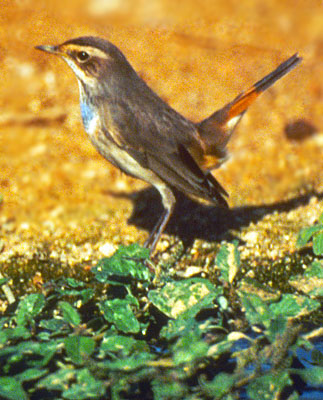
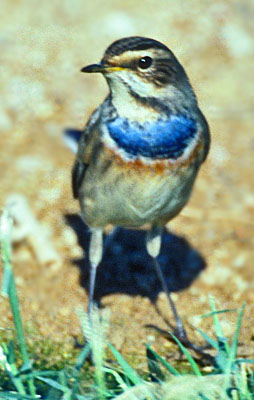
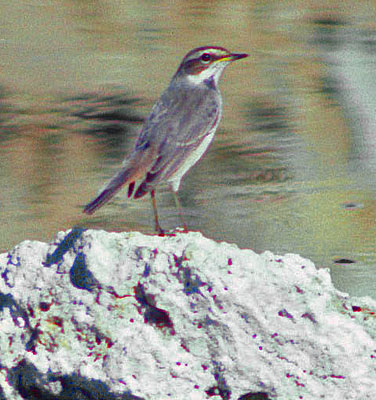


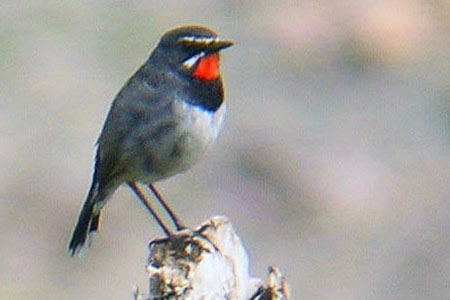
 The montane forests of eastern Eurasia are the breeding ground for a bevy of beautiful male songsters, including rubythroats and redstarts. All these species migrate south, where many become almost invisible skulkers in undergrowth or scrub on migration or in winter. Among them are a singing Siberian Rubythroat (upper left above), photographed through a tiny hole in the foreground foliage; male Chinese Rubythroat (lower left above) on a song post; and White-throated Redstart, male carrying food to an unseen nest. All these digiscoped shots were from a summer trip to montane China. The redstart and Siberian Rubythroat were in a rich mixed coniferous forest in Huzu NP where we were camping at 2500m elev. (8200'). The Chinese Redstart was in alpine scrub on the Qinghai Plateau above 3,260m (10,700').
The montane forests of eastern Eurasia are the breeding ground for a bevy of beautiful male songsters, including rubythroats and redstarts. All these species migrate south, where many become almost invisible skulkers in undergrowth or scrub on migration or in winter. Among them are a singing Siberian Rubythroat (upper left above), photographed through a tiny hole in the foreground foliage; male Chinese Rubythroat (lower left above) on a song post; and White-throated Redstart, male carrying food to an unseen nest. All these digiscoped shots were from a summer trip to montane China. The redstart and Siberian Rubythroat were in a rich mixed coniferous forest in Huzu NP where we were camping at 2500m elev. (8200'). The Chinese Redstart was in alpine scrub on the Qinghai Plateau above 3,260m (10,700'). 

 Africa also has its share of understory robins and chats, some of them very elusive and difficult to see. Forest Robin (below left) is among them, sticking close to the darkest parts of the forest floor in the Congo Basin and west African forests. It is usually located by its beautiful song. At the moment, most world checklists consider it a single species, in the monotypic genus Stiphrornis, with much geographic variation (up to 5 "Groups" in Clements' list). Yet there is published research that suggests that Forest Robin is actually comprised of at least 3 species (Boano et al. 2015, Voelker et al. 2017). Under that proposal, my photo, taken with flash on slide film in 1996 in Gabon, would be Olive-backed Forest-Robin S. pyrrholaemus.
Africa also has its share of understory robins and chats, some of them very elusive and difficult to see. Forest Robin (below left) is among them, sticking close to the darkest parts of the forest floor in the Congo Basin and west African forests. It is usually located by its beautiful song. At the moment, most world checklists consider it a single species, in the monotypic genus Stiphrornis, with much geographic variation (up to 5 "Groups" in Clements' list). Yet there is published research that suggests that Forest Robin is actually comprised of at least 3 species (Boano et al. 2015, Voelker et al. 2017). Under that proposal, my photo, taken with flash on slide film in 1996 in Gabon, would be Olive-backed Forest-Robin S. pyrrholaemus. 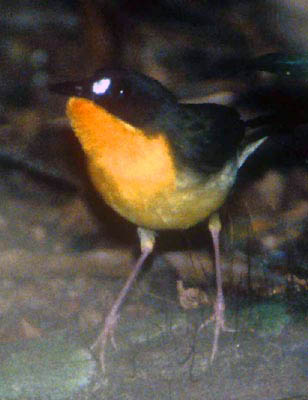
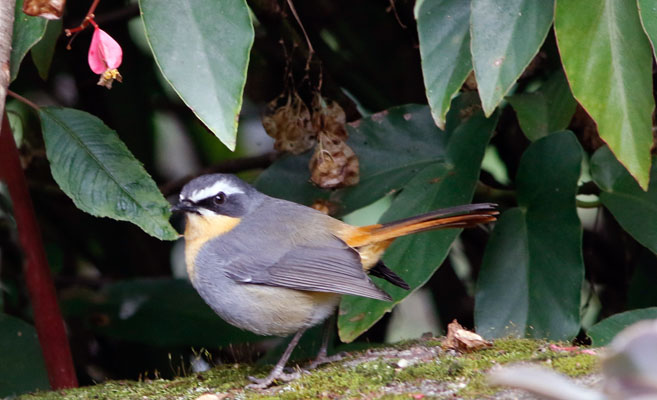
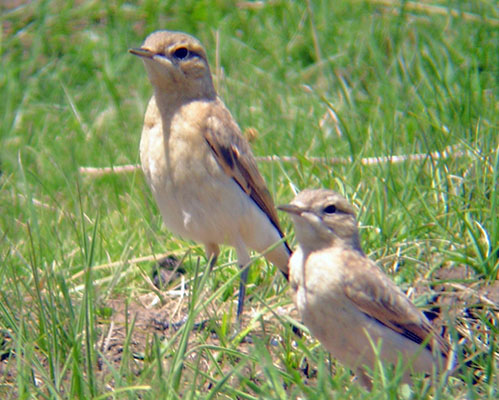


 Some muscicapids frequent rushing streams, bobbing their tails, dipper-like, in rhythm to the cascade. Forktails (genus Enicurus) behave that way. So do a number of redstarts, including the colorful White-capped Water Redstart (left) of the Himalayas. So does the rare and vulnerable Luzon Redstart Phoenicurus bicolor, a Philippine endemic.
Some muscicapids frequent rushing streams, bobbing their tails, dipper-like, in rhythm to the cascade. Forktails (genus Enicurus) behave that way. So do a number of redstarts, including the colorful White-capped Water Redstart (left) of the Himalayas. So does the rare and vulnerable Luzon Redstart Phoenicurus bicolor, a Philippine endemic. 

 There are a dozen species in genus Copsychus, which is comprised of Indian Robin (above left), seven shamas, and three magpie-robins. All the shamas are wonderful songsters, and yet all are content to sing from perches inside the bushes and can be difficult to see. One hears many more shamas than one sees. Most shamas are long-tailed to some extent, but the champion long-tailed species is White-rumped Shama (above right). It lives in dense thickets from India to southeast Asia, and on Sumatra, Borneo, and Java. Populations in Indonesia have taken a serious dive as keeping cage birds that can sing has become widespread. This particular photo is of a shama that has just taken a bath in forest pool.
There are a dozen species in genus Copsychus, which is comprised of Indian Robin (above left), seven shamas, and three magpie-robins. All the shamas are wonderful songsters, and yet all are content to sing from perches inside the bushes and can be difficult to see. One hears many more shamas than one sees. Most shamas are long-tailed to some extent, but the champion long-tailed species is White-rumped Shama (above right). It lives in dense thickets from India to southeast Asia, and on Sumatra, Borneo, and Java. Populations in Indonesia have taken a serious dive as keeping cage birds that can sing has become widespread. This particular photo is of a shama that has just taken a bath in forest pool. 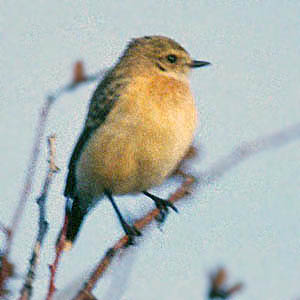

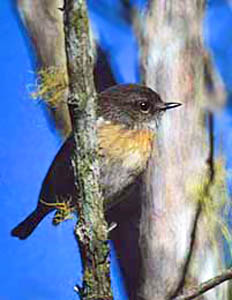
 There are currently 13 species on Clements' list of genus Saxicola. Six are stonechats, six are bushchats (including Gray Bushchat atop this web page), and Whinchat Saxicola rubetra. Some have extensive migrations while those from tropical regions or islands are sedentary. The split of Siberian Stonechat (left) from European Stonechat S. rubicola was controversial but was accepted by a book focused on genus Saxicola (Urquhart & Bowley 2003), and then generally adopted globally. Siberian Stonechat breeds from European Russia to Mongolia, and migrates to wintering grounds is south and southwest Asia. Inevitably, some individuals will make errors in that journey, spinning off vagrants to far-distant lands. One even reached San Clemente I., California, in in Oct 1995. This particular vagrant imm. Siberian Stonechat (upper left, above). was on the island of Texel, off the mainland coast of the Netherlands, in October 1991. It occurred during a meeting of rarities committee members from across Europe and USA, so was documented by many sharp birders then active.
There are currently 13 species on Clements' list of genus Saxicola. Six are stonechats, six are bushchats (including Gray Bushchat atop this web page), and Whinchat Saxicola rubetra. Some have extensive migrations while those from tropical regions or islands are sedentary. The split of Siberian Stonechat (left) from European Stonechat S. rubicola was controversial but was accepted by a book focused on genus Saxicola (Urquhart & Bowley 2003), and then generally adopted globally. Siberian Stonechat breeds from European Russia to Mongolia, and migrates to wintering grounds is south and southwest Asia. Inevitably, some individuals will make errors in that journey, spinning off vagrants to far-distant lands. One even reached San Clemente I., California, in in Oct 1995. This particular vagrant imm. Siberian Stonechat (upper left, above). was on the island of Texel, off the mainland coast of the Netherlands, in October 1991. It occurred during a meeting of rarities committee members from across Europe and USA, so was documented by many sharp birders then active. 


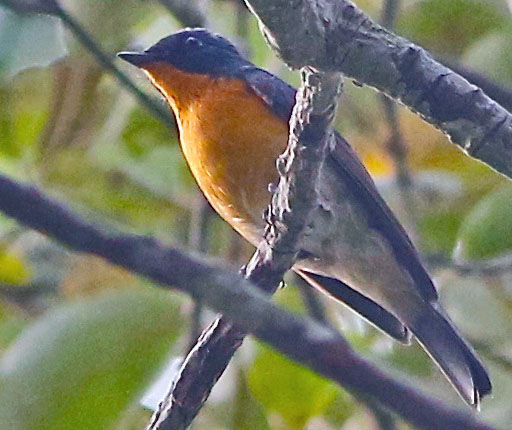
 Another colorful example in Ficedula flycatchers is Green-backed Flycatcher (left; initially known as Elisa's Flycatcher or Chinese Narcissus Flycatcher. For quite some time, most checklists considered a subspecies of Narcissus Flycatcher Ficedula narcissina of Japan. The photo is of a male of the taxon elisae, an endemic breeder to east China. At the same location in China as this bird, our group (led by Paul Holt) also saw several "Peking Flycatcher F. beijingnica" (Zheng et al. 2000) which is actually the first-summer male of F. elisae. In each case the "Peking" responded vigorously to the song of elisae, essentially proving they are the same species. Dickinson (2003) wisely does not consider "beijingnica" even a subspecies; he simply lumps it with elisae stating that "critical acoustic information is missing" from Zheng et al. (2000) and "the description might apply to a subadult form of elisae (which is exactly the case!). Paul Holt was in the forefront of getting this sorted out.
Another colorful example in Ficedula flycatchers is Green-backed Flycatcher (left; initially known as Elisa's Flycatcher or Chinese Narcissus Flycatcher. For quite some time, most checklists considered a subspecies of Narcissus Flycatcher Ficedula narcissina of Japan. The photo is of a male of the taxon elisae, an endemic breeder to east China. At the same location in China as this bird, our group (led by Paul Holt) also saw several "Peking Flycatcher F. beijingnica" (Zheng et al. 2000) which is actually the first-summer male of F. elisae. In each case the "Peking" responded vigorously to the song of elisae, essentially proving they are the same species. Dickinson (2003) wisely does not consider "beijingnica" even a subspecies; he simply lumps it with elisae stating that "critical acoustic information is missing" from Zheng et al. (2000) and "the description might apply to a subadult form of elisae (which is exactly the case!). Paul Holt was in the forefront of getting this sorted out. 

 We've almost ignored behavior in this short summary, but I've encountered odd and interesting behaviors occasionally, including these displaying Northern Anteater-Chat (right). This family group was calling and displaying on the floor of Ngorongoro Crater. It is said to be co-operative breeding, presumably with some of last year's young helping at the nest, and perhaps this is a communal display cementing those bonds? Not much is known, I guess. Also not much is known about Congo Moorchat (below), surveying its territory in open plains of southeaster Gabon from the top of a "toadstool" termite mound.
We've almost ignored behavior in this short summary, but I've encountered odd and interesting behaviors occasionally, including these displaying Northern Anteater-Chat (right). This family group was calling and displaying on the floor of Ngorongoro Crater. It is said to be co-operative breeding, presumably with some of last year's young helping at the nest, and perhaps this is a communal display cementing those bonds? Not much is known, I guess. Also not much is known about Congo Moorchat (below), surveying its territory in open plains of southeaster Gabon from the top of a "toadstool" termite mound. 
 I would be remiss to overlook the six niltavas (genus Niltava) and the 8 shortwings (two genera). All are highly sought species because of their beauty and their elusiveness. All are primarily birds to humid evergreen forest in the mountains of Asia and major islands. Most of the species have deep blue plumage; some have chestnut bellies. The brilliance of the lustrous indigo-blue color of a male Small Niltava, with its glittering highlights and blue shoulder bar, can be breathtaking (photo right). It is a Himalayan bird, frequenting edges and shrubberies in broadleaf evergreen forests, and then moving downslope to the foothills in winter.
I would be remiss to overlook the six niltavas (genus Niltava) and the 8 shortwings (two genera). All are highly sought species because of their beauty and their elusiveness. All are primarily birds to humid evergreen forest in the mountains of Asia and major islands. Most of the species have deep blue plumage; some have chestnut bellies. The brilliance of the lustrous indigo-blue color of a male Small Niltava, with its glittering highlights and blue shoulder bar, can be breathtaking (photo right). It is a Himalayan bird, frequenting edges and shrubberies in broadleaf evergreen forests, and then moving downslope to the foothills in winter.
